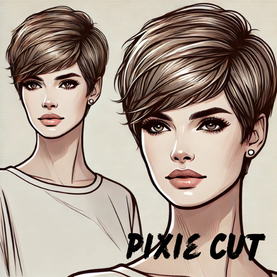1st Sep 2025
The Pixie Cut: History, Celebrities, and Tools Every Stylist Needs
Few hairstyles have captured the imagination of both celebrities and everyday clients like the pixie cut. From its roots in mid-century film to its resurgence on red carpets and fashion runways, the pixie has proven itself more than just a haircut—it’s a cultural statement.
But what makes the pixie so enduring? Let’s explore its origin, the icons who made it famous, why it’s still popular today, and the essential hair cutting tools stylists rely on to create this classic look.
✂️ The Origins of the Pixie Cut
The pixie cut first rose to prominence in the 1950s, most notably when Audrey Hepburn appeared in Roman Holiday (1953). Hepburn’s cropped locks stood in stark contrast to the longer, curled hairstyles that dominated the post-war era. The cut became synonymous with freshness, independence, and rebellion against traditional norms of femininity.
By the 1960s, the pixie cut evolved into a fashion movement. Supermodel Twiggy and actress Mia Farrow wore the look with confidence, redefining beauty standards and inspiring thousands of women to embrace short hair. It became more than a style—it was a symbol of liberation.
Celebrity Influence Across the Decades
The pixie cut has never truly left the spotlight. Each decade has brought its own icons who reinvented the look:
-
1970s–1980s: Stars like Annie Lennox pushed the pixie into edgy, androgynous territory.
-
1990s: Winona Ryder and Halle Berry brought back a chic, textured version that became instantly recognizable.
-
2000s–2010s: Emma Watson, Charlize Theron, and Anne Hathaway used the pixie as a post-blockbuster reinvention, showing how adaptable the style could be.
-
Today: Celebrities like Zoe Kravitz, Scarlett Johansson, and Florence Pugh continue to refresh the pixie cut with modern variations.
Every version reflects not only the times but also the personal brand of the celebrity wearing it.
Is the Pixie Cut Popular Today?
Yes—and for good reason. The pixie cut consistently ranks among the top short hairstyles requested in salons worldwide. Its popularity stems from:
-
Low maintenance: Less styling time for busy clients.
-
Versatility: Works with straight, wavy, or curly textures.
-
Confidence factor: A bold haircut that highlights facial features and personal style.
-
Customization: Can be worn sleek and smooth, tousled and textured, or even paired with undercuts and fringe.
For stylists, this means the pixie cut is more than a classic—it’s an evergreen service opportunity.
Tools That Bring the Pixie Cut to Life
Precision is everything when it comes to short hair. A great pixie depends on clean lines, controlled layering, and intentional texture. That’s why professionals rely on the best hair shears, hair cutting shears, and hair texturizing shears.
-
Hair Cutting Shears: Used to establish the strong foundational lines of the pixie. A sharp, high-quality pair ensures clean, precise cuts without splitting the hair.
-
Hair Shears: Essential for refining and shaping layers, giving balance to the overall silhouette.
-
Hair Texturizing Shears: The secret weapon for pixies. They soften edges, remove bulk, and create movement that prevents the style from looking too harsh. Texturizers are especially useful for tailoring the cut to the client’s hair density and growth patterns.
-
Swivel Thumb Shears: Perfect for ergonomics during intricate short cuts, allowing stylists to cut comfortably at different angles without wrist strain.
By combining these tools, stylists can sculpt a pixie cut that’s sharp, wearable, and easy to maintain.
✅ Styling and Maintenance Tips
A pixie cut isn’t just about the cut itself—it’s about the daily styling that makes it personal.
-
For sleek looks: Use smoothing cream and a flat iron to create polished lines.
-
For textured styles: Work with styling paste or wax to define layers cut with hair texturizing shears.
-
For volume: Blow-dry at the roots using a round brush or diffuser to add lift.
-
Maintenance: Trims are required every 4–6 weeks to keep the shape sharp.

